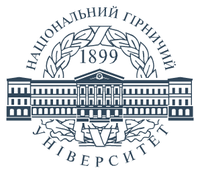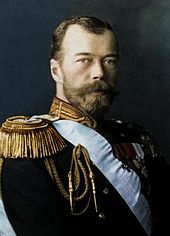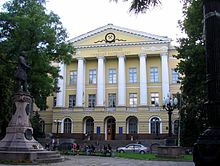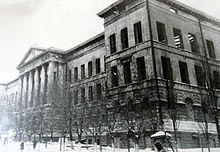- National Mining University of Ukraine
-
National Mining University Національний гірничий університет 
Motto Національний гірничий університет - відповідність часу Motto in English National Mining University - correspondence to time Established June 16, 1899[1] Type Public[2] Rector Genadiy Grygorovych Pivnyak Admin. staff 850 Students 16,000[2] Location Dnipropetrovsk, Ukraine Affiliations Magna Charta Universitatum, Black sea universities network (BSUN); Euroasian Universities Association (EUA); International Society for Engineering Education (IGIP); International Society for Rock Mechanics (ISRM); International University of Resources (IUR); World Mining Congress (WMC), International Association of Universities Website www.nmu.org.ua The National Mining University (Ukrainian: Національний гірничий університет), colloquially known in Ukrainian as NGU (Ukrainian: Національний гірничий університет - НГУ) is located in Dnipropetrovsk, the third most populous city in Ukraine. It was founded in 1899 as the Yekaterinoslav Higher Mining School[3]. The task of the university then was to provide the mining industry with highly qualified specialists[3], a goal that has continued to direct the university's leadership right up to the present day, although in recent years its academic offer has developed beyond the confines of mining-related subjects. Currently, its structure consists of nine faculties (academic departments). During the Soviet era, NGU was one of the country's top specialised institutions of higher education. It is ranked as one of Ukraine's best universities in many rankings and today attracts a large number of foreign students.
The National Mining University is one of the leading establishments of higher education in Ukraine. According to the ratings of UNESCO it achieved 6th position among the 200 Top universities in Ukraine in 2009.[2]
Contents
The university today
At the University there are 53 departments (27 of which are major-based) united into 9 faculties of full-time education. There is also an Institute of Extramural and Distance Learning and a number of post-graduate and doctoral courses. The university has an Interbranch Institute of Continuing Learning, Scientific and Research Unit, Ukrainian-American Linguistic Center, Linguistic Center, Ukrainian German Cultural Center, Ukrainian-Spanish-Latin-American Center, Center for Ukrainian-Polish Cooperation, and Energy Saving and Energy Management Center. NGU also has links with the Prydniprovsk Science-and-Technology Center of Information Protection, Ukrainian-American Lyceum, Marganets College, Pavlograd Technical School and Motor Transport Technical School.
Currently there are 12,000 students enrolled on programs at the university, whilst post-graduate and doctoral students are taught in 27 modern specialties. The licensed amount of student admission for entering the University each year is 1,400 students. The academic process is provided by 600 teachers including more than 100 doctors of science, professors and 350 candidates of Science and associate professors. The infrastructure of the University (general area of constructions and buildings is 126049 square meters estimated at 29,8 mln. hryvna cost), modern computer basis (more than 1000 modern computers) local and global computer nets, library funds with more than one million volumes, strong material and technical laboratory basis, ensures a high standard of education.
Over the 100 years of the university's existence more than 56,000 highly qualified specialists have been prepared, more than 500 monographs and 250 study-books widely known beyond Ukraine have been published, and about 150 Doctors of science and more than 1,750 Candidates of science have been trained. The university's graduates are today authors of more than 2600 inventions in foreign countries, where they obtained more than 300 patents. In recent years, four fundamental innovations of the university’s scientists have been recognised as scientific discoveries.
History
The foundation ceremony of Ekaterinoslav's Higher Mining Technical School (EHMTS) was conducted on October 12, 1899, and in April of the next year construction of the institution's new educational buildings began. To begin with the Higher Mining Technical School had only two departments, those of mining and factory-production, but their academic curricula differed only very slightly (the main difference between the two faculties was to be found in the number of taught hours conducted for students).
 The Yekaterinoslav Higher Mining Technical School was founded during the reign of Nicholas II.
The Yekaterinoslav Higher Mining Technical School was founded during the reign of Nicholas II.
The curriculum according to the “Regulation for the EHMTS” foresaw an initial total of 23 taught disciplines: theology, higher mathematics, analytical mechanics, construction mechanics, applied mechanics, mine-factory mechanics, physics, chemistry, electrical mechanics, mineralogy, geology and deposit science, geodesy, mining art, ore and coal dressing, surveying, metallurgy, technology of metals, design and geometric design, accounting and mine-factory economy, technical translation from German and French and first aid at accidents. The provision of training was undertaken by a total of 13 full-time employed teachers.
From the date of its foundation the university was equipped with a two department library, a mineralogical museum, chemical, mechanical and probe laboratories, and offices for each discipline. Nevertheless the Technical School had a lot of problems for a long time. Ten years after EHMTS establishment there were only 9 teachers, and the stable cadre was constantly decreasing. This made the issue of equalising the Technical School's rights with other higher educational institutions more urgent, and thus eventually the school was turned into the Ekaterinoslav Mining Institute. On June 19, 1912 the State Legislative body adopted a resolution on restructuring the EHMTS into a fully equipped Mining Institute. Since July 1st a number of outstanding scientists, mainly graduates from Saint-Petersburg Mining Institute, then joined the institute.
The institute became well known for its many publications in scientific periodicals. The EHMTS edited and produced the “News of Ekaterinoslav Higher Mining Technical School” since 1905 and up until 1917 the school published 23 collections of “News”, in which around 500 scientific works were published (including monographs and study books).
In 1918 the Mining Institute opened two new departments: surveying (closed in 1921) and Geological Prospecting, and obtained the right to award scientific degrees through public defence of a scientific dissertation. Later, in 1921 the Mechanical Faculty was created with two departments, those of Mining-Factory and Electrical Engineering. The implementation of new specialties was from then on dictated by industrial development. Finally a distance and
In 1930 the Mining Institute began training specialists only for the mining industry and geological prospecting works, and in 1932 a number of new faculties were established in place of the departments: Mining, Electrical Engineering, Geological-Surveying. In the 20s and 30s the process of forming scientific schools was continued, and therefore during the late 1930s the Dnipropetrovsk Mining Institute lost a significant part of its staff (about 30 persons, among which there were a number of outstanding professors),however, the institution withstood these losses and kept preparing highly professional specialists for industry and science.
As a result of the Great Patriotic War in 1941-1945 about 300 teachers, staff members and students left for the front within the first few days of hostilities commencing. The institute evacuated to Sverdlovsk and Karaganda, to where a significant part of its equipment was brought and where its faculty began to work alongside the scientific staff of the Sverdlovsk Mining Institute and the Filial of Moscow Mining Institute, which by that time had come to Karaganda too. A great number of the Dnipropetrovsk Mining Institute's staff occupied engineering positions at mining enterprises of the Urals and Soviet Republics of Middle Asia, working for victory over Nazi Germany.
The Institute finally resumed its teaching activities in 1943, first in Karaganda, and later in Dnipropetrovsk. However, after the German invasion of the USSR and later Lower Dnieper Offensive, many of the institute's buildings were in ruin and required extensive reconstruction before the staff was able to move its educational activities back into them. After the war, on November 21, 1949 the Dnipropetrovsk Mining Institute was awarded with the Order of the Red Banner and a number of its staff members received high state awards (26 orders and 17 medals) for scientific achievements and success in training engineering and technical staff for the national economy. By 1951/52 academic year all the buildings of the institute had been completely rebuilt, with a new experimental study range for boring, a geological museum, and new laboratories and dormitories being put into use. In 1951 the Mine-Construction Faculty was established.
By its 50th anniversary the Institute had 165 professors, associate professors and lecturers, 1,942 students, 34 departments, 22 laboratories, 25 cabinets, a geological museum, library, experimental study range and experimental workshops.
In 1970 the Dnipropetrovsk Mining Institute employed 474 teachers, including 34 professors. At that time the amount of graduating engineers equaled 1,200 persons and the amount of specialists studying in full-time education was increasing, although part-time and extramural study forms also functioned.
In May 1993 according to the results of State accreditation for higher educational institutes, the Dnipropetrovsk Mining Institute gained the status of an autonomous IV-accreditation level state higher educational institution and received the name of the State Mining Academy of Ukraine. In February 2002 the institution was finally restructured into its current form as the "National Mining University". Today it is one of the leading higher educational institution of the country in geological prospecting and mining fields.
Rating
The National Mining University's placing in the annual rankings of universities in Ukraine:
Ranking 2007 2008 2009 2010 2011 Compas 6[4] 6[4] 6[5] 6[6] 6[7] Structure
The faculties of the university are:
- Institute of Power Engineering
- Institute of economics
- Mining faculty
- Faculty of construction
- Faculty of Mechanical Engineering
- Faculty of Geological Prospecting
- Faculty of Law
- Institute of Extramural and Distance Learning
- Interbranch Institute of Continuing Learning
Notable alumni
- Vitold Fokin - former Prime Minister of Ukraine[8]
- Yulia Tymoshenko (1978-79) - former Prime Minister of Ukraine and Orange Revolution leader
- Evgen Dovzhok - Meritous explorer of the USSR and discoverer of several oil fields
- Rotislav Didyk - Professor of Novosibirsk State University, PhD, professor, member of the Academy of Engineering Sciences of Ukraine, member of the New York Academy of Sciences (USA)
- Ernest Yefremov - Member of the National Academy of Sciences of Ukraine, doctor of technical sciences, professor, twice awarded the State Prize of Ukraine.
- Nikolai Kucherskoy - General director of Navoi Mining and Metallurgical Plant, PhD, member of Mining Academy of the Russian Federation, twice winner of the USSR State Prize, honorary professor of NGU
- Vladimir Molozhen - Deputy Minister of Internal Affairs of Moldova, Minister for Information Technology and Telecommunications of Moldova
- Yaroslav Nalyvayko - CEO, chairman of the Western Ukrainian coal holding company
- Zhu Xun - Ex-Minister of Geology of China, chairman of the Association of Alumni of the former Soviet Union and the CIS
References
- ^ (Ukrainian) History, University official website
- ^ a b [1]
- ^ a b Message of Greeting from Rector, University official website
- ^ a b Загальний рейтинг ВНЗ 2007-2008
- ^ Загальний рейтинг ВНЗ 2009
- ^ Загальний рейтинг ВНЗ 2010
- ^ http://www.yourcompass.org/htm%20tables%20new/Compass2011-All.html
- ^ (Ukrainian) Outstanding Alumni, University official website
External links
- official website (Ukrainian)\(Russian)\(English)
- Department of Computer system's software, NMU (Russian)
Categories:- Universities in Ukraine
- Ukraine university stubs
Wikimedia Foundation. 2010.




